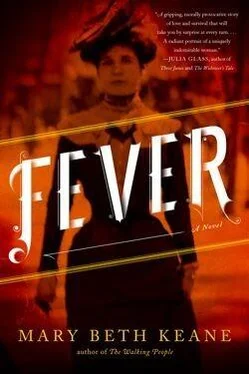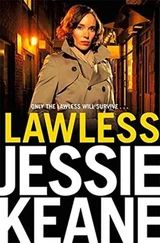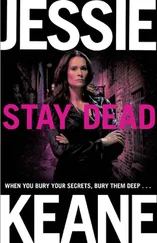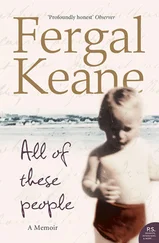“So I’m now cook for the Bowens and the Comptons?”
“I don’t think we’re meant to see it that way,” said Ida, the third cook. “I think we’re to see it as the three of us cooking enough of a meal to do for six families. Not you have these two, or you your two, and so on. You see?”
“And where are the cooks for the other families?” Mary didn’t see. She usually considered herself the brightest in any group, but the Bowen girl had been feeling poorly and she was distracted by it. Again and again she’d tried to get up to the girl’s room, and again and again she was barred. No one had yet mentioned the word Typhoid .
“The other cooks were scaled back,” said Clare. “Told they are needed only Wednesday on.”
“So,” Mary said, like she was waking up from a dream, “we cook here as a group and deliver the food to all these families. That way six families get fed for the price of three cooks instead of six cooks.”
The three looked at one another.
“For the purpose of saving money?” Mary said. It didn’t seem like the right answer, but there couldn’t be any other.
“There’s something like this happening on the West Side,” Ida said. “I have a friend. Her employer calls it a cooks’ cooperative. It’s cheaper for them, and she says that the idea is that after a while we won’t work for one particular family anymore. We’ll be asked to leave our rooms. Then we’ll have to get rooms elsewhere and commute to the place we are to cook just like any other day cook or common laborer.”
“We won’t do this,” Mary said to the other cooks. And that night, for the first and last time in her life, Mary intentionally ruined good food, and talked the other two into doing the same. They overcooked the tenderloins. They boiled the asparagus until it was stringy mush. They withheld salt from the potatoes and put it on the cobblers instead.
“I hope it turned out well,” Mary said to Mr. and Mrs. Bowen when she served them later. “I’m not used to having to transport my dishes. It’s best, you see, straight from the oven to the table.”
“Could you not choose a dish, Mary, that would support being transported?” Mr. Bowen asked, as he probed the meat with the tine of his fork.
“Of course,” Mary said, bowing her head. “We could limit ourselves to just a few dishes that we know would work.”
“Limit?” Mrs. Bowen asked, and pushed her plate away.
• • •
Once Elizabeth got sick, and they realized it was Typhoid Fever, there was no more mention of cooking in the church hall, or of cooking at all for that matter. Mary made bread and a thin soup that would keep, and spent most of her hours hauling ice up the stairs and the empty bucket back down — the only helpful thing they would allow her to do. They kept the block in the kitchen sink and Mary put Frank to work charging at it with a butcher knife until it came to pieces, little ones to suck, larger ones to serve as floes in the tubs upstairs where the family bathed, and the single tub downstairs where the servants took turns. There was an ice shortage in 1907, and ice was very dear, but Mary ordered blocks on credit and hoped they wouldn’t ask for a settlement of their books before the girl recovered.
• • •
In their first interview, Mr. O’Neill asked Mary why death didn’t bother her, why she didn’t notice it following her everywhere she went. Mary didn’t even know where to look for a starting point. After so many months on North Brother, so many years since setting foot in Dobbs Ferry, Mary could still feel the silk of Tobias Kirkenbauer’s curls when he passed under her hand, and the way he settled himself on her hip, his arm slung around her neck, as if he had no fear in the world as long as she was holding him. How could anyone think she didn’t notice, or that it didn’t bother her? No one in any court of law, no man in any room, knows the desperation of squinting through dim light and seeing a baby’s cheeks inflamed, feeling the hot hands, the eyes gone flat with fever. A twist came in Mary’s belly that was the beginning of a prayer. Back in 1899, when little Tobias Kirkenbauer wouldn’t open his mouth to eat, who pressed the creamy water from the boiled oats and spooned it into his mouth? I did, Mary reminded herself. And he held on longer than he would have if Mary hadn’t been there. But they didn’t know about 1899. To them, 1899 was not on the record books.
And if it was really true that Elizabeth Bowen died, then of course that bothered her. Of course. The girl was only a child, and deserved no badness.
When Mary was a child, her grandmother told her that as long as she kept the piss pot clean and her apron white, there would be no mistress who would turn up her nose at her. It was over her grandmother’s turf fire that Mary learned how to make griddle cakes and brown bread, where she first browned bacon and boiled beef, made salmon with butter and cream, eel and trout. It was her grandmother who taught her the best way to tuck the turnips and potatoes around the meat, and it was her grandmother who saved enough to buy Mary a one-way passage to America when Mary was fourteen. There would be food in America that Mary had never seen, but the rules were the same: cook it right, draw out what’s good, don’t be afraid of putting things together. Her grandmother’s sister, Kate Brown, would give Mary a place to live, help her find work in New York. “Send her,” Kate’s letter back to Mary’s grandmother had read. “I’d love to have her.”
Mary’s first impression of America when she arrived in Castle Garden in 1883 was that it wasn’t a kind place. Soon after she had steadied herself, her bag secure in her hand, she was hustled into one grim line after another, like one mangy cow in a herd. Other ships had also arrived that day and she waited and watched as the kaleidoscope of colors kept shifting: green aprons, yellow head scarves, red tassels brushing the ground, dotted ribbon pulled through belt loops to hold up short pants. The American men were the ones with the broad faces, and derby hats pulled low. She imagined a welcoming party, but instead one ugly man shoved a card in her face and another, even uglier, braced Mary’s head with his large hand and told her to hold still while he used a buttonhook to lift her left eyelid and then her right. “Trachoma,” he said. “Highly contagious.” Mary didn’t understand the first word and barely heard the others, locked as she was in a posture of fear. When he finished and announced her eyes clean, she noticed that the man wiped the hook on a towel draped over the railing before moving on to his next victim.
Paddy Brown, Aunt Kate’s husband, met Mary when she’d completed all the lines and gotten all her stamps. “Mary Mallon?” he said when she approached the only man left in the waiting area that fit his description. “Follow me.” She followed him down a flight of stairs to the sunshine outside. They passed through the gates of what seemed like fortress walls, and then she was on the outside, on the streets of New York City. They climbed aboard a trolley drawn by a pair of glum-looking horses. When they came to the end of the track, they got out and made their way on foot. Mary struggled to keep up with the old man, who with his hunched shoulders and his badger’s head kept disappearing into the crowd. “Where is this?” she asked, hoping conversation would slow his pace. “Where are we now?” He raised a callused finger and pointed roughly at a street sign that read “Thirty-Seventh Street.” Finally, as the crowds thinned, and she followed him onto Tenth Avenue, Paddy Brown loosened his stride.
“Wait here a minute,” he said just before ducking into a store with a tuft of wheat carved on the sign outside.
Читать дальше












